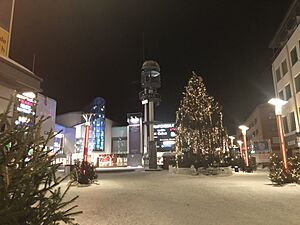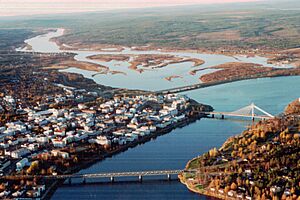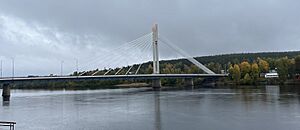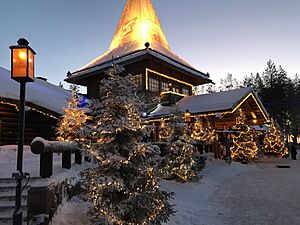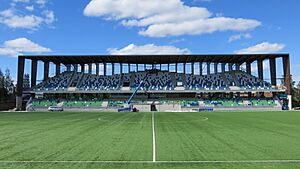Rovaniemi facts for kids
Quick facts for kids
Rovaniemi
Roavvenjárga (Northern Sami)
Ruávinjargâ (Inari Sami) Ruäʹvnjargg (Skolt Sami) |
|||
|---|---|---|---|
|
Municipality
|
|||
| Rovaniemen kaupunki Rovaniemi stad City of Rovaniemi |
|||

Clockwise from top: the Rovaniemi Church, the Rovaniemi Airport, the Santa Claus Village, downtown Rovaniemi, a view of the city from Ounasvaara, the Arktikum Science Museum, and aurora borealis in Someroharju.
|
|||
|
|||
| Nickname(s):
Arctic Capital; Hometown of Santa Claus
|
|||
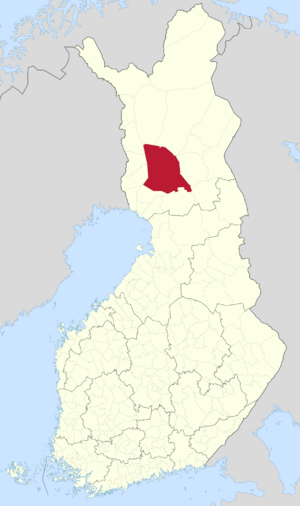
Location of Rovaniemi in Finland
|
|||
| Country | Finland | ||
| Region | Lapland | ||
| Sub-region | Rovaniemi sub-region | ||
| Charter | 1929 | ||
| City | 1960 | ||
| Area
(2018-01-01)
|
|||
| • Total | 8,016.75 km2 (3,095.28 sq mi) | ||
| • Land | 7,581.63 km2 (2,927.28 sq mi) | ||
| • Water | 434.75 km2 (167.86 sq mi) | ||
| Area rank | 5th largest in Finland | ||
| Population
(2023-12-31)
|
|||
| • Total | 65,286 | ||
| • Rank | 17th largest in Finland | ||
| • Density | 8.61/km2 (22.3/sq mi) | ||
| Population by native language | |||
| • Finnish | 94.8% (official) | ||
| • Swedish | 0.2% | ||
| • Sami | 0.3% | ||
| • Others | 4.7% | ||
| Population by age | |||
| • 0 to 14 | 16.3% | ||
| • 15 to 64 | 63.8% | ||
| • 65 or older | 19.9% | ||
| Time zone | UTC+02:00 (EET) | ||
| • Summer (DST) | UTC+03:00 (EEST) | ||
| Website | www.rovaniemi.fi | ||
Rovaniemi is a city in Finland and the main city of Lapland. It is located close to the Arctic Circle in the northern part of the country. About 65,000 people live in Rovaniemi. It is the 17th largest municipality in Finland by population.
Rovaniemi is the main city and business center for Lapland. It sits about 6 kilometers south of the Arctic Circle. The city is between two hills, Ounasvaara and Korkalovaara. It's also where the Kemijoki and Ounasjoki rivers meet. Rovaniemi is the second-largest city in Northern Finland, after Oulu. It's also one of Finland's most important cities for tourists, especially from other countries.
On January 1, 2006, Rovaniemi city and the surrounding rural area joined together. The city's coat of arms was designed by Toivo Vuorela. It shows a silver "pall" (a Y-shaped symbol) on a green background. There is also a golden flame in the top corner.
Contents
About the Name
The name Rovaniemi might come from the Sámi word roavve. This word means a forested ridge or a place where an old forest fire happened. The niemi part of the name means "cape" or "peninsula."
City History
People started clearing land for farming in the Rovaniemi area a very long time ago, around 750–530 BC. Items found here show that travelers from different areas came to Rovaniemi from 500 AD onwards. The Sami people are native to this region.
Rovaniemi was first officially mentioned in documents in 1453. It was a group of small villages. People mostly farmed and raised animals, and also fished and hunted.
In the 1800s, using Lapland's natural resources helped Rovaniemi grow. A lot of logging and a "gold fever" brought many people to Lapland. As more natural resources were used, Rovaniemi became the main business hub of Lapland.
Rovaniemi became its own market town on January 1, 1929. This meant it separated from the older rural municipality.
World War II Impact
During World War II, Finland had to remove German forces from its land. In the Lapland War, German troops used a "scorched earth" tactic as they left. This meant they destroyed things as they went.
On October 13, 1944, the German army was ordered to destroy almost all buildings in Rovaniemi. Only hospitals and houses with people inside were to be spared. While this was happening, an ammunition train at Rovaniemi station exploded. This caused the wooden houses in the town to catch fire.
Many German soldiers were hurt by flying glass. A Finnish unit said they blew up the train, which might have caused the widespread destruction. Because of these events, about 90% of all buildings in Rovaniemi were destroyed. There is a German cemetery nearby for soldiers who died in Lapland during the war.
Most of the city's buildings today were built after 1944. When Rovaniemi was rebuilt, a famous Finnish architect named Alvar Aalto helped design it. He planned the city's layout to look like a reindeer's head. The city roads form the antlers, and the local sports stadium is the reindeer's eye.
City Geography
Weather and Climate
| Weather chart for Rovaniemi | |||||||||||||||||||||||||||||||||||||||||||||||
|---|---|---|---|---|---|---|---|---|---|---|---|---|---|---|---|---|---|---|---|---|---|---|---|---|---|---|---|---|---|---|---|---|---|---|---|---|---|---|---|---|---|---|---|---|---|---|---|
| J | F | M | A | M | J | J | A | S | O | N | D | ||||||||||||||||||||||||||||||||||||
|
42
-8
-15
|
34
-8
-14
|
36
-3
-9
|
31
4
-4
|
36
11
2
|
59
17
7
|
69
20
11
|
72
17
9
|
54
10
4
|
55
3
-1
|
49
-3
-8
|
42
-6
-13
|
||||||||||||||||||||||||||||||||||||
| temperatures in °C precipitation totals in mm source: World Meteorological Organization |
|||||||||||||||||||||||||||||||||||||||||||||||
|
Imperial conversion
|
|||||||||||||||||||||||||||||||||||||||||||||||
Rovaniemi is near the Arctic Circle, so it has a subarctic climate. Summers are short and pleasant. Winters are long, cold, and snowy. Even though it's very far north, the ocean air from the North Atlantic Current makes winters less extreme than they could be.
In winter, there isn't much sunshine because of the city's location and often cloudy skies. For example, December gets less than six minutes of sunshine each day.
Rovaniemi set a new world record for continuous sunshine. From July 1 to July 6, 2021, the sun shone for 122 hours straight! The average temperature in Rovaniemi is about 0.9°C (33.6°F). Snow usually covers the ground for about 175 days a year.
The coldest temperature ever recorded at the airport was -38.1°C (-36.6°F) in January 1999. The hottest temperature ever recorded was 32.2°C (90.0°F) in July 2018.
Rovaniemi experiences polar day (when the sun doesn't set) from June 7 to July 6. However, it does not have a polar night (when the sun doesn't rise). In winter, the sun barely gets above the horizon.
Population and Languages
Rovaniemi has about 65,286 people. Most people in Rovaniemi speak Finnish as their first language. This is about 94.8% of the population.
A small number of people, about 0.3%, speak Sámi, which is Finland's third official language. Many other languages are spoken in Rovaniemi too. The most common foreign languages are Russian, English, Arabic, Chinese, and Ukrainian.
As of 2023, about 4.9% of the people in Rovaniemi have a foreign background. Most foreign-born residents come from Sweden, the former Soviet Union, China, and Russia.
Economy and Tourism
Since Rovaniemi is the main city of Lapland, many government offices are located here. About 10,000 students live in Rovaniemi. The city is home to the University of Lapland and the Lapland University of Applied Sciences. These schools offer studies in technology, business, health, forestry, and sports.
Visiting Rovaniemi
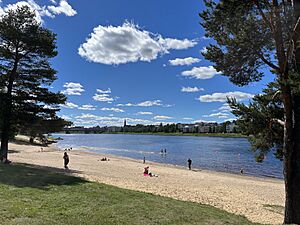
Tourism is a very important business in Rovaniemi. The area has beautiful nature and many fun things to do. The city has many hotels and restaurants. Over 481,000 visitors came to Rovaniemi in 2013. You can see and hear tourism everywhere, especially at the Arctic Circle and Rovaniemi Airport. The airport is one of Finland's busiest, especially around Christmas.
Many Finns believe Rovaniemi is the official hometown of Santa Claus. You can visit the Santa Claus Village right on the Arctic Circle. There's also SantaPark Arctic World, which is about 8 kilometers north of the city center.
Across the river from the town is the Ounasvaara ski center. People have been doing fun activities here since 1927. The top of Ounasvaara hill is also where some of the oldest human settlements in the area were found.
Another amazing sight that brings many tourists is the Aurora Borealis, also known as the Northern Lights. In Finnish Lapland, you can see the Northern Lights up to 200 times a year! In southern Finland, it's usually fewer than 20 times.
Main Attractions
Some of Rovaniemi's most famous places include:
- The Jätkänkynttilä bridge, which has an "eternal flame" over the Kemijoki river.
- The Arktikum Science Museum, which is a museum about the Arctic regions of Finland and the world.
- The Rovaniemi city hall.
- The Lappia Hall, which is a theater, concert hall, and meeting place.
- The library.
The city hall, Lappia Hall, and library were all designed by the famous architect Alvar Aalto.
Sports and Activities
Rovaniemi has several sports teams:
- Football (Soccer) Clubs: Rovaniemen Palloseura (RoPS) plays in Finland's third division. FC Santa Claus plays in the sixth division.
- Ice Hockey Team: Rovaniemen Kiekko (RoKi) plays in Mestis, Finland's second-highest league. Their home is Lappi Areena.
- Volleyball Team: Team Lakkapää plays in the Finland Volleyball League. They won national championships in 2003, 2007, 2008, and 2011.
- American Football Team: The Rovaniemi Nordmen started in 2013.
Rovaniemi has also hosted many international ski competitions. These include the FIS Nordic World Ski Championships 1984 and the 2005 FIS Nordic Junior World Ski Championships. In 2021, Rovaniemi hosted the World Rally Championship for the first time. This was the first WRC event held inside the Arctic Circle.
Transportation
VR Group, Finland's state railway, runs direct trains from Rovaniemi Station. You can travel to cities like Oulu, Tampere, Helsinki, and Turku.
Rovaniemi Airport is about 10 kilometers north of the city center. It is the second-busiest airport in Finland, after Helsinki-Vantaa Airport. The airport is busiest during the Christmas season, when many people come for "Santa Flights."
Famous People from Rovaniemi
- Antti Autti: A snowboarder who won a gold medal at the 2005 Winter X Games.
- Antti Iivari: An ice hockey player.
- Tomi Putaansuu: Also known as Mr. Lordi, the lead singer of the hard rock band Lordi, which won the 2006 Eurovision Song Contest.
- Harri Olli: A ski jumper.
- Tanja Poutiainen: An Alpine skier.
- Antti Tuisku: A popular singer.
Sister Cities
Rovaniemi has "sister city" relationships with several cities around the world:
- Ajka, Hungary
- Alanya, Turkey
- Cadillac, United States
- Grindavík, Iceland
- Harbin, China
- Kassel, Germany
- Kiruna, Sweden
- Narvik, Norway
- Neustrelitz, Germany
- Olsztyn, Poland
- Sankt Johann in Tirol, Austria
- Veszprém, Hungary
In March 2022, Rovaniemi stopped its agreement with Murmansk, Russia. This was due to the conflict in Ukraine.
See also
 In Spanish: Rovaniemi para niños
In Spanish: Rovaniemi para niños




